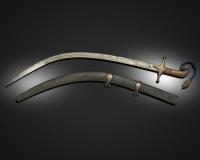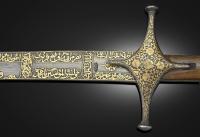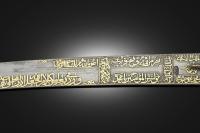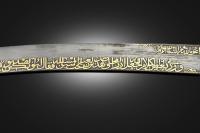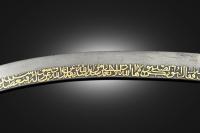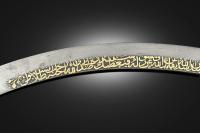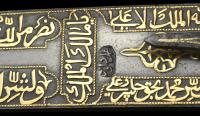
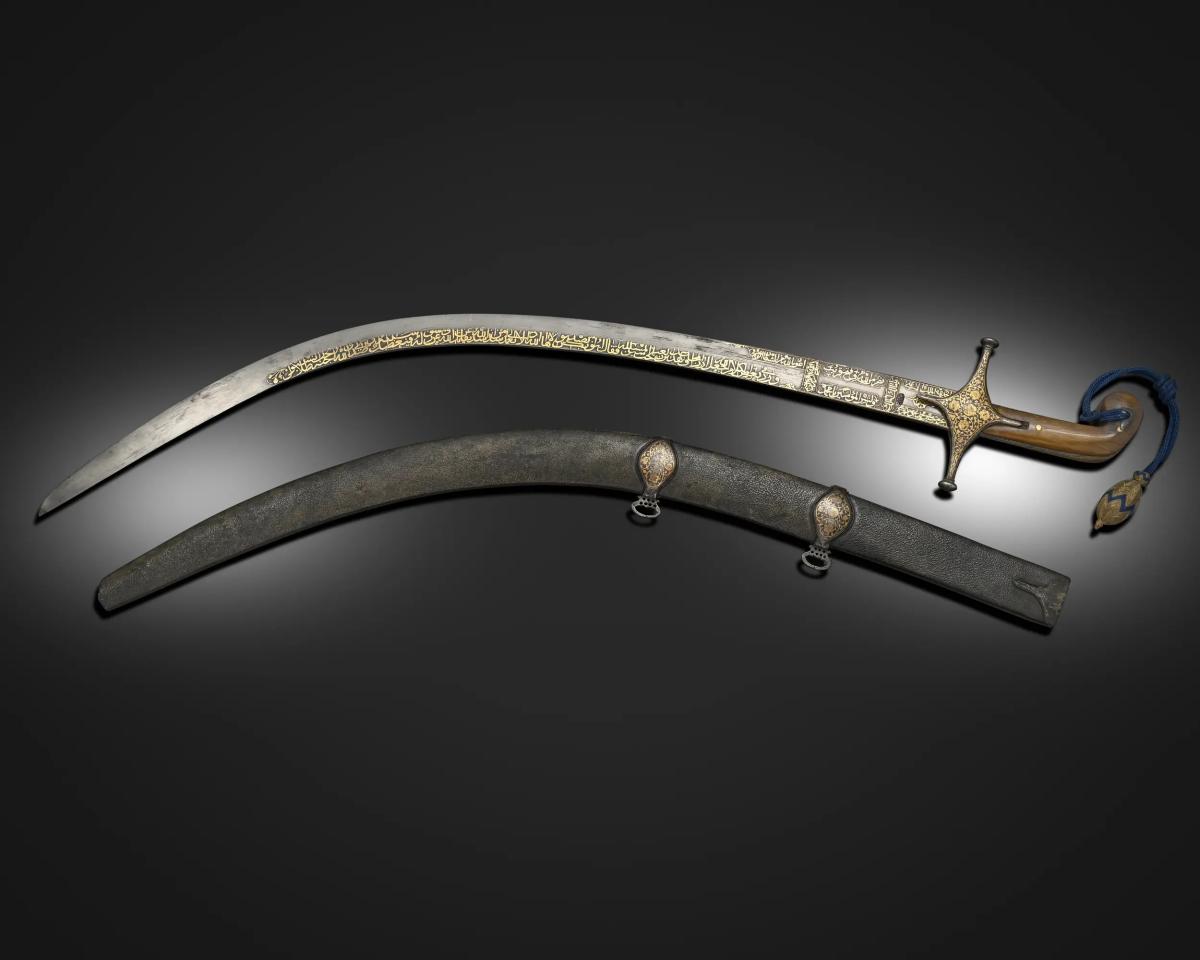
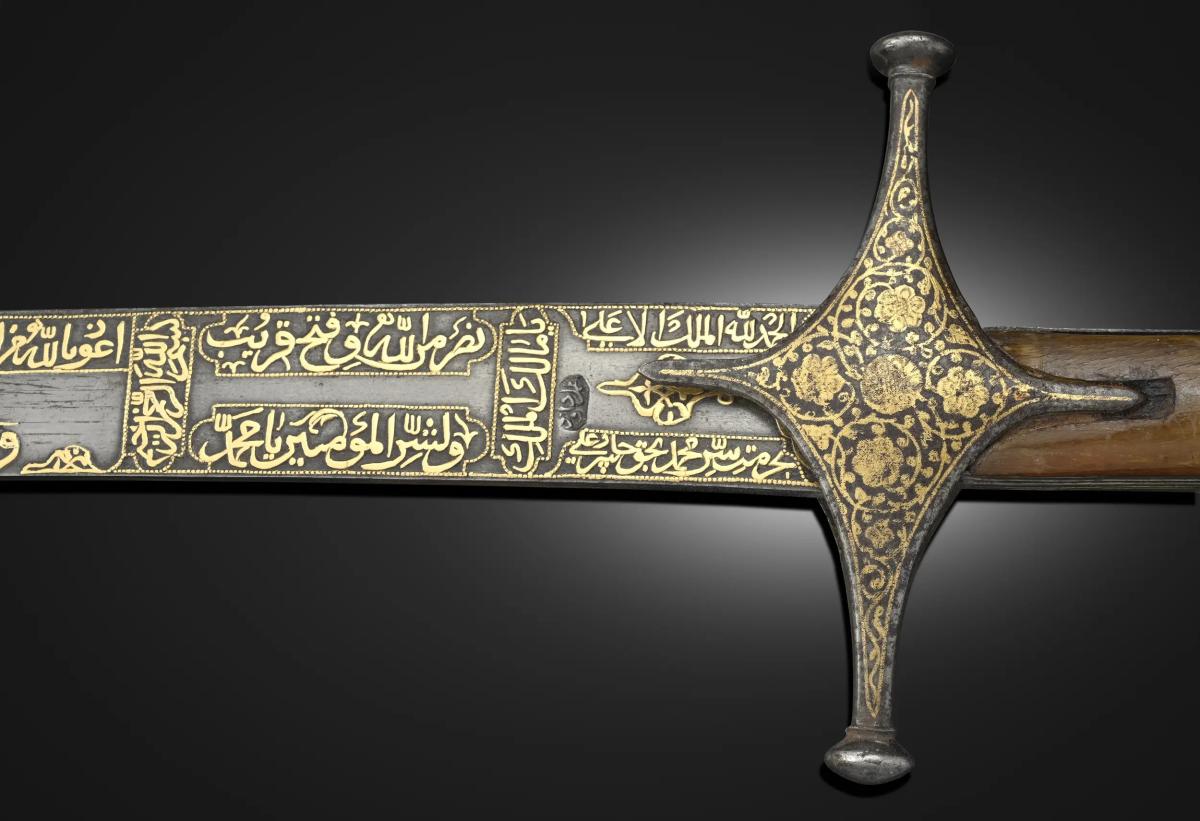
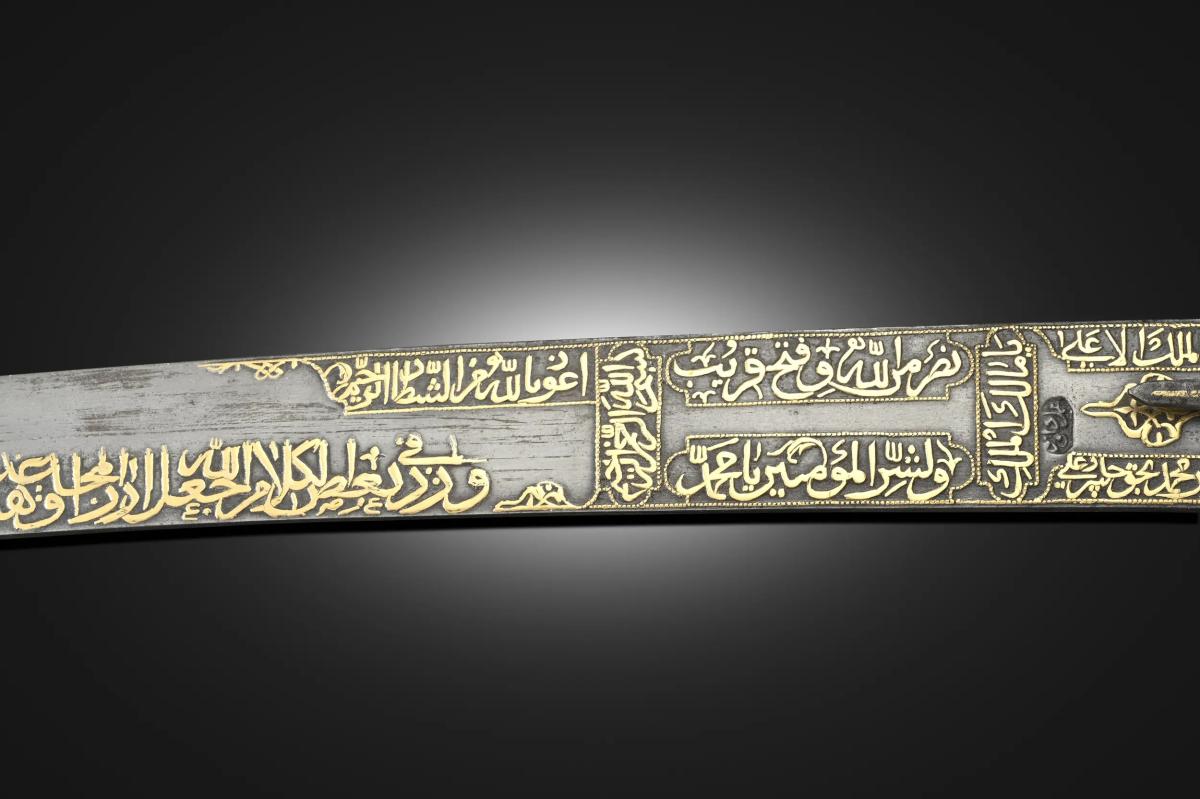
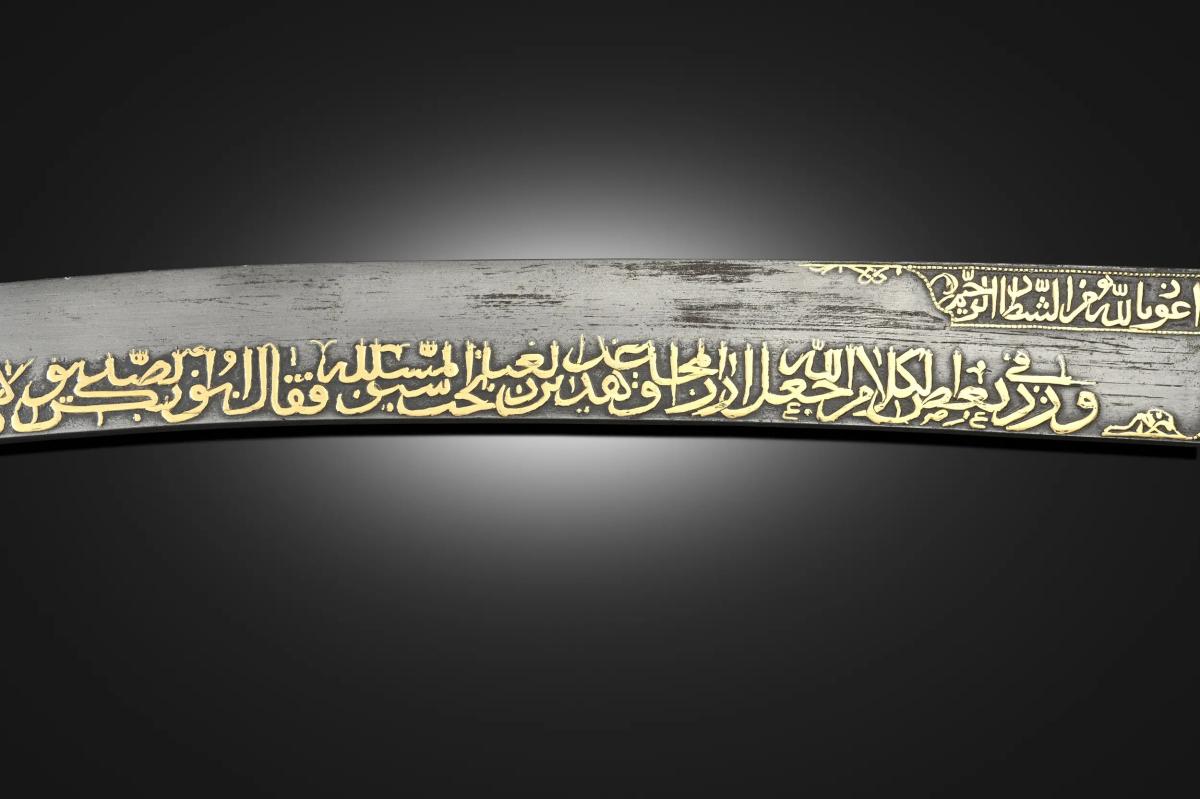
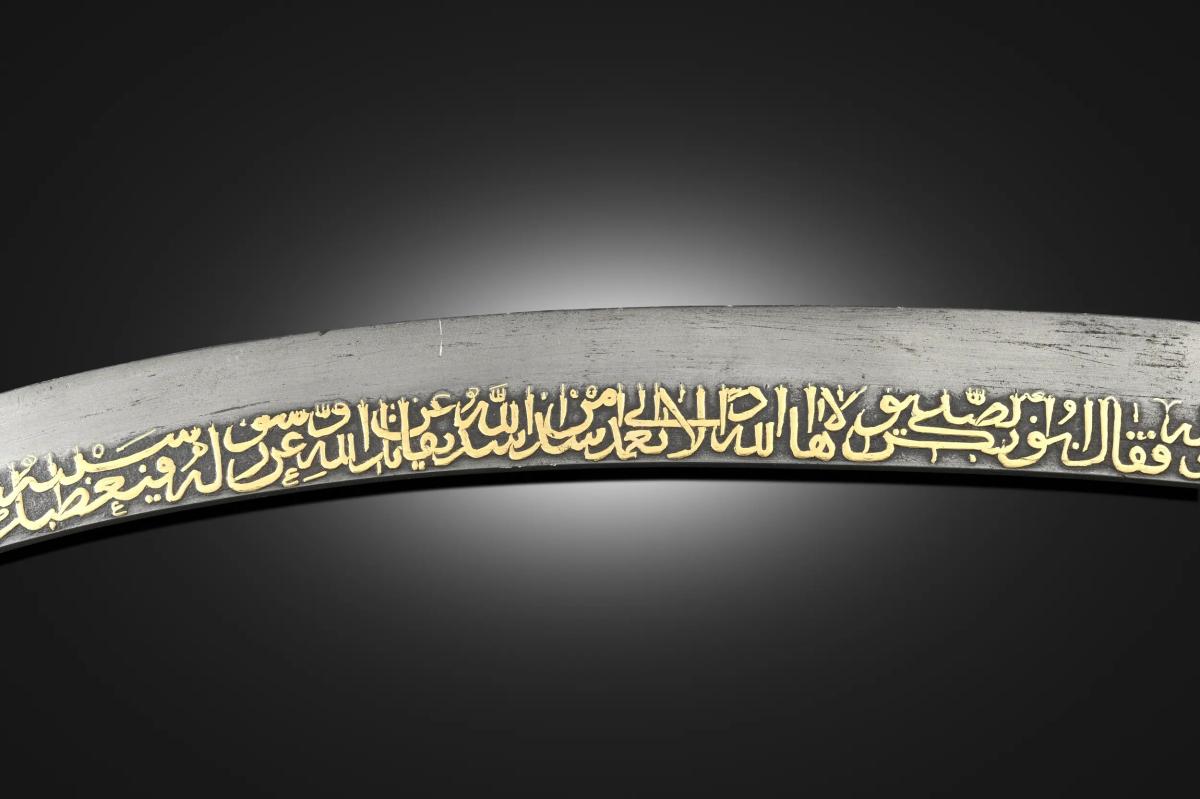
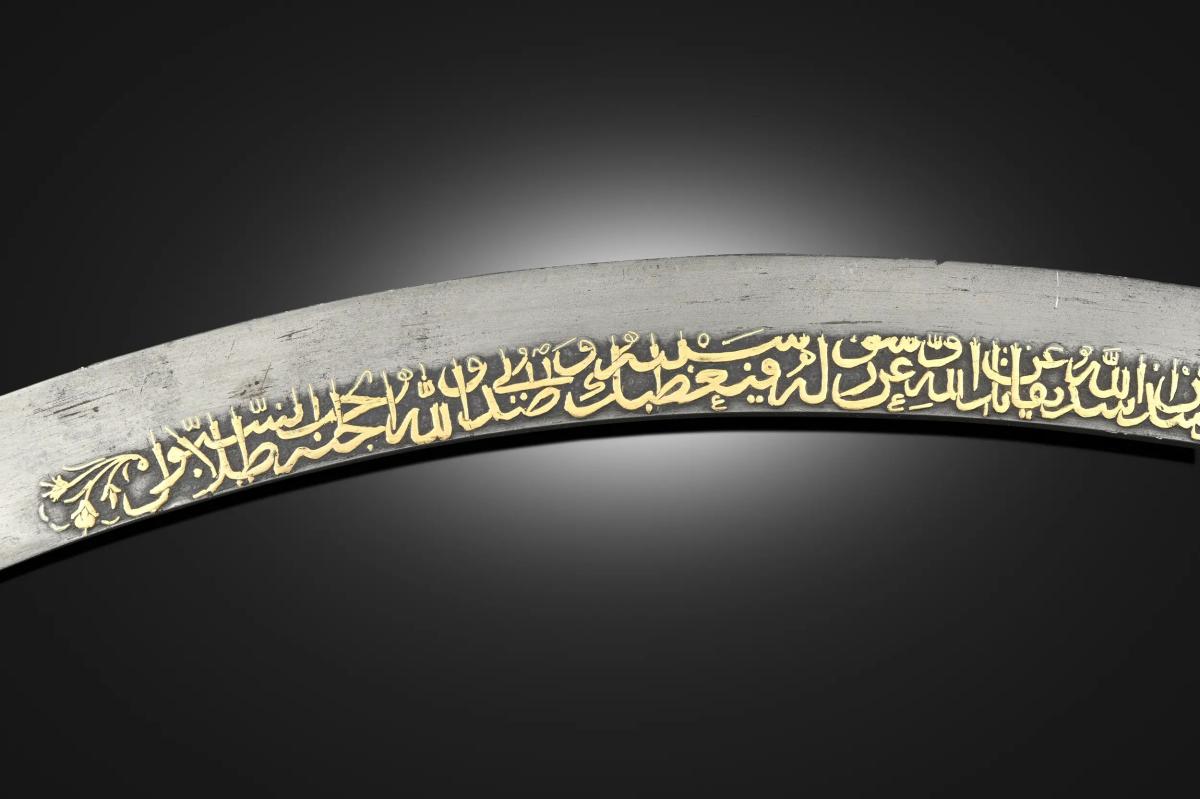
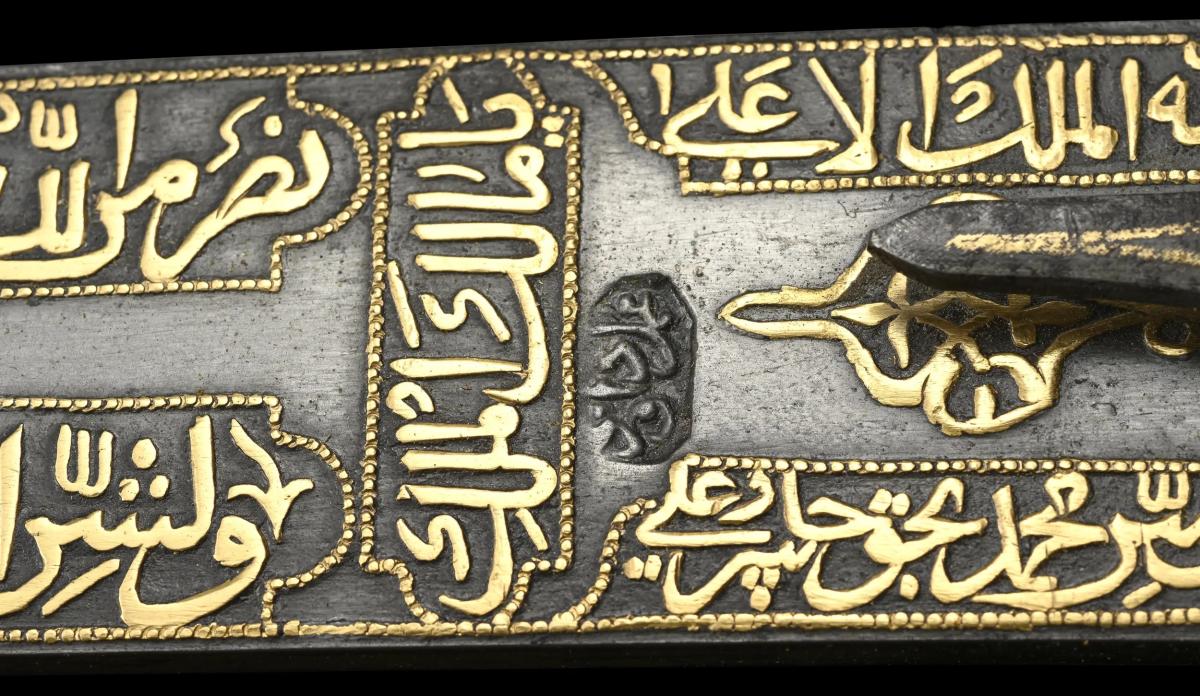
Price on application
This object is eligible for a Certificate of BADA Provenance
The BADA Standard
- Since 1918, BADA has been the leading association for the antiques and fine art trade
- Members are elected for their knowledge, integrity and quality of stock
- Our clients are protected by BADA’s code of conduct
- Our dealers’ membership is reviewed and renewed annually
- Bada.org is a non-profit site: clients deal directly with members and they pay no hidden fees
Extremely Rare and Important Ottoman Sword Signed By Sultan Murad IV’s (R. 1623-1640) Court Swordsmith Davud.
Ottoman Empire.
Master Davud’s Workshop, Istanbul.
Signature: عمل داود ‘Amal Davud (Work of Davud).
Blade: Circa 1623-1640.
Hilt: 18th Century.
Scabbard: 18th Century.
Blade Length: 75 cm.
Overall Length with Scabbard: 90.5 cm.
Gently-curved steel blade with flat edge, decorated with extremely fine raised gold Arabic inscriptions in thuluth script running along one side, the horn hilt with gold-inlaid cross guard, the scabbard covered with leather and decorated with two gold-inlaid suspension rings.
The original Arabic text, transliterations and translations of the raised gold inscriptions on the blade are as follows:
Insciptions:
1.
اعوذ بالله من الشيطان الرجيم
A’udha b’illāh min al-shaytān al-rajīm.
I take refuge to God from the accursed Satan.
2.
بسم الله الرحمن الرحيم
Bism Allāh al-Rahman al-Rahīm.
“In the name of God the most merciful, the most compassionate”. [The Qur’an 1:1]
3.
نصر من الله و فتح قريب و بشر المؤمنين يا محمد
Nasrun min allāhu wa fathun qarīb wa bashshir al-mu’minīn ya Muhammad.
“Victory is from God and the conquest is close. Oh Muhammad, give the good news to the believers”. [The Qur’an 61:13]
4.
يا مالك الملك
Ya Mālik al-Mulk.
“Oh [God!], the owner of all possessions”.
5.
الحمد الله الملك الاعلي بحرمت سر محمد بحق سر علي
Al-hamdu lillāh al-malik al-a‘la bi hurmat sirr Muhammad bi haqq sirr ‘Alā.
“Thank God, the king, the mighty, with reverence to Muhammad’s mystery with verity of the esteemed confidence”.
6.
ورد في بعض الكلام جعل الله ارزق المجاهدين عن العباد من سيوف المسيلله فقال ابوبكر الصديق
لَاهَا اللَّهِ إذًا لا يَعْمِدُ إلى أَسَدٍ مِن أُسْدِ اللَّهِ يُقَاتِلُ عَنِ اللَّهِ ورَسولِهِ يُعْطِيكَ سَلَبَه صدق الله الجنت تخت الظلال السيوف
Warada fī ba‘dal kalām ja‘ala allāh arzaq al-mujāhidīn ‘an al-‘ibād min suyūf al-musaylillāh faqāla Abū Bakr al-Siddīq lā hā allāhi izan lā ya‘midu ilā asadin min asadillāhi yuqātilu ‘an allāhi wa rasūlihi yu‘tīka salabahi sadaqa allāh al-jannatu takht al-zilāl al-suyūf.
“It has been recorded that God brought provisions of the holy warriors among believers through the swords of the Muslims. Caliph Abū Bakr said: ‘I swear to God, such a thing has never happened, a soldier as brave as a lion, one of the lions of God, fights for God and his Prophet, and gives the booty to you’. Verity is with God. Paradise is under the shadow of swords”.
Comparisons
There are only a few 17th century Ottoman swords that bear the signature of a court swordsmith or that can be directly associated with the court workshops. One of these is an early 17th century sword, made for Sultan Ahmed I (r. 1603-1617) in the Topkapi Palace Museum (inv. no. 1/80). See, Hilmi Aydin, Sultanlarin Silahlari – Topkapi Sarayi Silah Koleksiyonu (Sultans’ Weapons – Arms in the Topkapi Palace Museum), Istanbul, 2007, p. 57.
There is a comparable sword in the Topkapi Palace Museum which is recorded in the museum’s inventory as the sword of Sultan Murad IV (inv. no. 1/484). This unsigned sword was probably also made by Master Davud, the swordsmith of Sultan Murad IV. On the blade of the sword of Sultan Murad IV in the Topkapi Palace is a raised gold inscription in thuluth script, stylistically very close to our sword’s inscriptions, which reads “al-Sultān ibn al-Sultān, al-Sultān Murād Khān” (the Sultan son of the Sultan, the Sultan Murad Khan).
There is only one other recorded sword bearing Master Davud’s signature. This sword, signed with the artist’s name, was sold at Christie’s, London, for £313,250. Please see, Art of the Islamic and Indian World, on 4 October 2012, Lot: 248. Ours, which is previously unrecorded, is the second.
Comparable late 16th, early 17th century Ottoman swords decorated with raised gold inscriptions in the Furusiyya Art Foundation Collection are published in Bashir Mohamed’s The Arts of the Muslim Knight – The Furusiyya Art Foundation Collection, Skira, 2007, pp. 63-65. For other comparable examples decorated with raised gold inscriptions see, Ü. Yücel, Islamic Swords and Swordsmiths, IRCICA, Istanbul, 2001.
The raised gold inscriptions of one of the swords in the Furusiyya Art Foundation Collection, reading “for the treasury of the great Sultan, the noble, the generous”, bear striking stylistic resemblance to the inscriptions on the present sword. See, Bashir Mohamed, The Arts of the Muslim Knight – The Furusiyya Art Foundation Collection, Skira, 2007, p. 63, No. 27.
This magnificent sword which was probably made for Sultan Murad IV, belongs to a small group of imperial Ottoman swords. Besides its very fine craftmanship and high artistic value, it is historically important, documenting the artistry of Murad IV’s court swordsmith Master Davud.
Master Davud in Ottoman Historian and Traveller Evliya Çelebi’s (d. 1682) Book of Travels
The famous 17th century Ottoman historian and traveller Evliya Çelebi (d. 1682) praises Master Davud in his famous ten-volume book of travels, the Seyahatnâme. We learn from Evliya Çelebi that Davud was Sultan Murad IV’s (r. 1623-1640) chief court swordsmith (kılıçcıbaşı) who was responsible for making his swords.
Evliya Çelebi gives the following information about Master Davud in the first volume of his book of travels, dedicated to Istanbul:
“… dükkân-ı seyyâfân 205 ve cümle neferât 1007 … cümle ehl-i hırefe takaddüm olundu. Cümle ehl-i sefer ve ehl-i hazar bu esnafa muhtaçdır … Bunların … zamanımızda kârhâneleri Mahmud Paşa hamamı mukabelesinde hâne-i azîmdir. Ser çeşmeleri Dâvud-i Asamîdir ki Sağır Dâvud demekle meşhur-i âfâkdır. Sultan Murâd Han-ı Râbi‘ ol kadar şemşîrbâz iken bu Sağır Dâvud kılıcından gayrı Ispahan karhânesi kılıcı bile dest-i kuvvetine dayanmazdı. Ol ecilden hatt-ı şerif ile kılıçcıbaşı olmuştu.” Evliyâ Çelebi Seyâhatnâmesi, transliterated by Robert Dankoff et al, YKY, Istanbul, 2013, Vol I, p. 884.
The translation of this section reads as follows:
“[In Istanbul] … there are 205 swordsmith workshops and 1007 swordsmiths in total … These swordsmiths are more popular than all other artists because all soldiers and warriors are in need of a good swordsmith. Today their main workshops are across the Mahmud Pasha bath-house. The leader of these swordsmiths is Davud-i Asamī who is world-famous. He is also known as Davud the deaf. Sultan Murad IV who was a very skilled swordsman, was never satisfied with his swords, even with those made in Isfahan workshops, and would only use Master Davud’s swords. For this reason Davud was appointed chief court-swordsmith (kılıçcıbaşı) to Sultan Murad IV with an imperial edict.”
For references to Evliya Çelebi’s entry on Master Davud also see, Hilmi Aydın, Sultanların Silahları – Topkapı Sarayı Silah Koleksiyonu (Sultans’ Weapons – Arms from the Topkapi Palace Museum), Istanbul, 2007, p. 66. Also see, Hilmi Aydin’s article “Topkapı Sarayı’ndaki Osmanlı Padişah Kılıçları” (Ottoman Imperial Swords in the Topkapi Palace), Osmanlı, Vol: 11, Yeni Türkiye Yayınları, Ankara, 1999, sf. 561-572.
Swords played an important role both in ceremonies and battles in the history of the Islamic civilisation. The earliest examples of concave edged swords, also-known as Arab or Turkish swords, were found in Jabal (Biblos) and dated to 1800 B.C. Swords were highly prized as gifts and some precious swords were presented to the holy Ka’ba in Mecca as presents. In the 7th century, in Medina, there was a famous swordsmith called Abu al-Sayf (Father of the Sword).
The Prophet Muhammad had nine swords which were named: “ma’sūr (inherited from his father), adb, dhulfiqār (which was later given by the Prophet Muhammad to Caliph ‘Ali), qal’ī, hatf, rasūb, mihzem, ma‘sūb and samsāmah”. See, Nebi Bozkurt’s article “Kılıç”, TDV İslam Ansiklopedisi, Vol. XXV, Ankara, 2002, pp. 405-408. The holy relics section in the Topkapi Palace Museum, Istanbul, houses twenty swords, two of which are Prophet Muhammad’s. These are straight, double-edged swords. Some of the earliest Muslim concave edged swords were used by the Mamluks. The swords of Sultan Qalawun (inv. no. 1/2524) and Sultan Qaytbay (inv. no. 1/181, 1/182) in the Topkapi Palace Museum are concave edged swords. In the Islamic world, the following cities were famous with their swords; Ubulla (Iraq), Damascus, Kirman, Qum, Khorasan, Isfahan, Cairo, Toledo, Sevilla, Granada.
One of the earliest Ottoman concave-edged swords belongs to Sultan Mehmed the Conqueror which is in the Topkapi Palace Museum (inv. no. 1/90). The sword was one of the main Ottoman signs of sovereignty. Before he was enthroned, every Ottoman sultan was expected to visit the Mausoleum of Eyub al-Ansari (d. 674), one of the companions of Prophet Muhammad buried in Istanbul, and gird his sword in this mausoleum. Muslim dynasties had great respect for swords due to the famous hadith (saying) of the Prophet Muhammad which is repeated on the present sword: “Paradise is under the shadow of swords”.
Provenance
Ex-Private German Collection.
The BADA Standard
- Since 1918, BADA has been the leading association for the antiques and fine art trade
- Members are elected for their knowledge, integrity and quality of stock
- Our clients are protected by BADA’s code of conduct
- Our dealers’ membership is reviewed and renewed annually
- Bada.org is a non-profit site: clients deal directly with members and they pay no hidden fees


